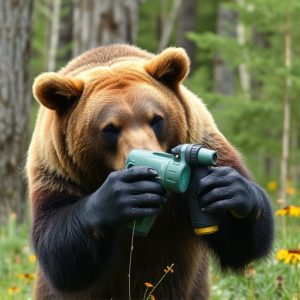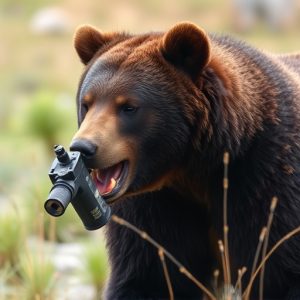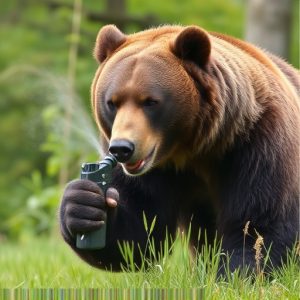Navigating Alaska’s Hiking Trails: Bear Repellents & Gear Guidelines
Understanding bear encounters in Alaska is crucial for hikers, given the risk of 200-300 bear-human…….
Understanding bear encounters in Alaska is crucial for hikers, given the risk of 200-300 bear-human conflicts annually. While bear spray is a vital safety measure, its use is regulated and prohibited in some national parks due to environmental concerns. Hikers should check local regulations, opt for alternative defenses like poles, flashlights, and whistles, wear layered clothing, and secure their backpacks to minimize risks in areas where bear spray is banned.
Alaska’s vast wilderness offers breathtaking scenery but also presents unique challenges, especially when hiking in bear country. Understanding bear encounters and navigating the state’s regulations on bear spray is essential for any outdoor enthusiast. This article explores the risks of bear interactions, delves into the effectiveness of bear spray, provides gear considerations, and sheds light on where bear spray use is prohibited in Alaska, ensuring a safe and informed adventure.
- Understanding Bear Encounters in Alaska: Risks and Statistics
- The Role of Bear Spray: Effective Repellent or Misconception?
- Gear Considerations for Hiking in Bear Country
- Where is Bear Spray Prohibited in Alaska: Exploring the Rules and Regulations
Understanding Bear Encounters in Alaska: Risks and Statistics
Understanding bear encounters in Alaska is crucial for any hiker or outdoor enthusiast. With a diverse range of bear species, including grizzly bears and black bears, the risk of an encounter varies across different regions. While Alaska’s vast wilderness offers breathtaking experiences, it’s essential to be aware that these areas also serve as bear habitats. Statistics show that bear encounters, while relatively rare, can have significant consequences. According to the Alaska Department of Fish and Game, an average of 200-300 bear-human conflicts occur annually, with a small percentage resulting in fatal attacks.
Knowing where bear spray is prohibited is also essential for safe hiking. Bear spray, a popular repellent, is effective against both grizzly bears and black bears. However, certain areas, such as national parks and some remote wilderness zones, may have restrictions on carrying and using bear spray to protect sensitive ecosystems and prevent human-wildlife conflict. Hikers should always check local regulations before heading out, ensuring they are prepared with the right gear and knowledge to navigate Alaska’s beautiful but potentially dangerous terrain.
The Role of Bear Spray: Effective Repellent or Misconception?
Bear spray, also known as bear repellent, has long been considered a crucial component of hiking gear in areas inhabited by bears. It’s often touted as an effective way to deter and scare off potential bear encounters, even grizzly bears, with its high-pressure stream of capsaicin-based chemicals designed to cause temporary blindness and severe irritation. However, the role of bear spray as a reliable repellent is a topic of debate among experts.
While numerous studies claim that bear spray can effectively reduce bear aggression in certain situations, there are also instances where it has been found less than useful. Some bears may not react as expected due to factors like distance, wind direction, or even individual behavior patterns. Moreover, where is bear spray prohibited? In some national parks and wilderness areas, the use of bear spray is strictly regulated or banned altogether because it can negatively impact wildlife, cause environmental damage, and pose risks to other hikers. Therefore, understanding its limitations and being prepared for encounters without relying solely on bear spray is essential for a safe hiking experience in bear country.
Gear Considerations for Hiking in Bear Country
When hiking in bear country, choosing the right gear is paramount for your safety. One of the most crucial items to consider is a reliable bear repellent, particularly bear spray. Unlike what many might assume, not all locations allow the use of bear spray. It’s essential to research and understand where it is prohibited; certain parks or wildlife reserves may have strict rules against carrying bear spray to protect sensitive ecosystems or avoid disturbing wild bears.
In such areas, opt for other defensive measures like robust hiking poles that can double as weapons, strong and bright flashlights, and loud whistles to startle bears if needed. Wear sturdy clothing with layers to protect against unexpected encounters, and ensure your backpack is secure and well-closed to prevent any unwanted interactions with curious bears.
Where is Bear Spray Prohibited in Alaska: Exploring the Rules and Regulations
In many wilderness areas across Alaska, bear spray is an essential tool for hikers and outdoor enthusiasts to protect themselves from potential bear encounters. However, it’s crucial to understand that there are specific places where carrying and using bear spray is prohibited. The state’s regulations aim to balance the need for safety with preserving wildlife habitats and minimizing environmental impact.
Where Is Bear Spray Prohibited? Alaska has stringent rules regarding the use of bear spray, particularly in sensitive ecosystems and near human settlements. Some areas, such as national parks and preserves, have strict no-spray policies to protect vulnerable wildlife and their habitats. Additionally, certain trails and recreational sites within forests may restrict the use of bear spray due to proximity to communities or high-traffic areas. Hikers should always check with local authorities or park rangers before venturing into these zones to ensure compliance with the rules and regulations regarding bear spray usage.
When hiking in Alaska’s diverse landscapes, understanding bear encounters and choosing the right gear are vital for a safe adventure. While bear spray has long been touted as an effective repellent, it’s crucial to know its limitations and where it’s prohibited. Navigating these factors enables hikers to make informed decisions, ensuring a responsible and enjoyable experience amidst Alaska’s majestic bears. Remember that knowledge is the best defense when exploring “the Last Frontier.”


